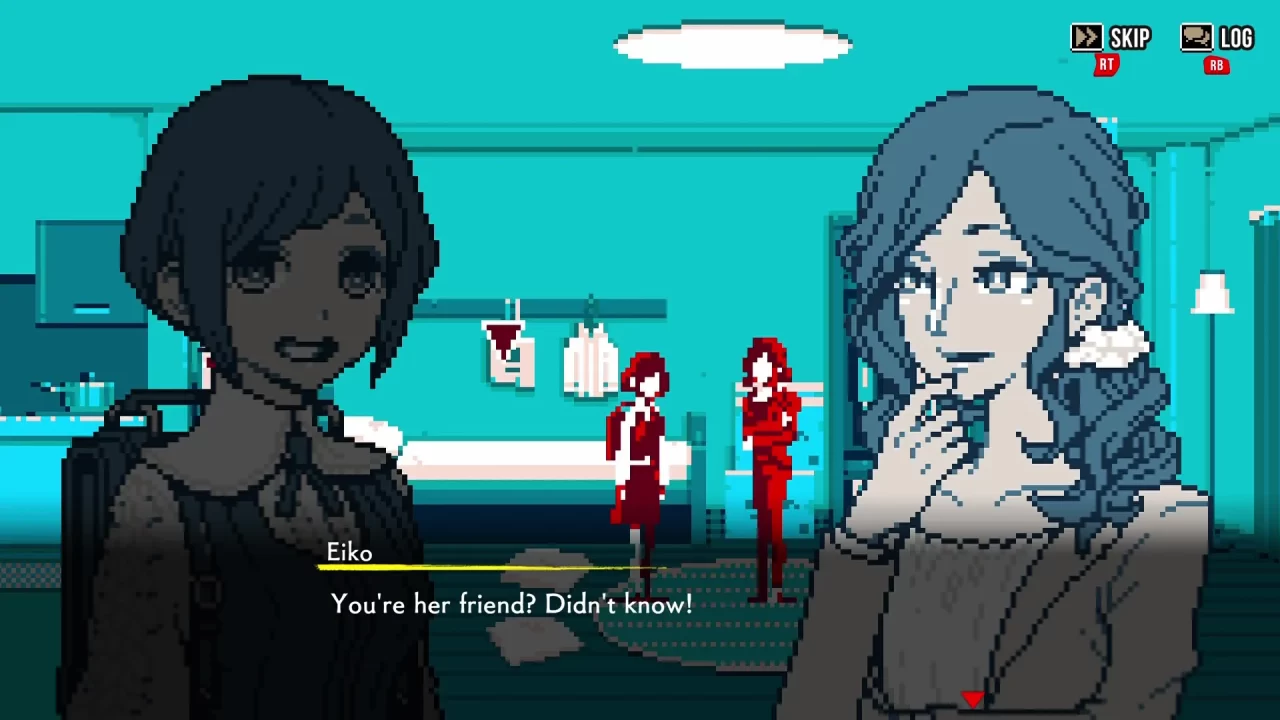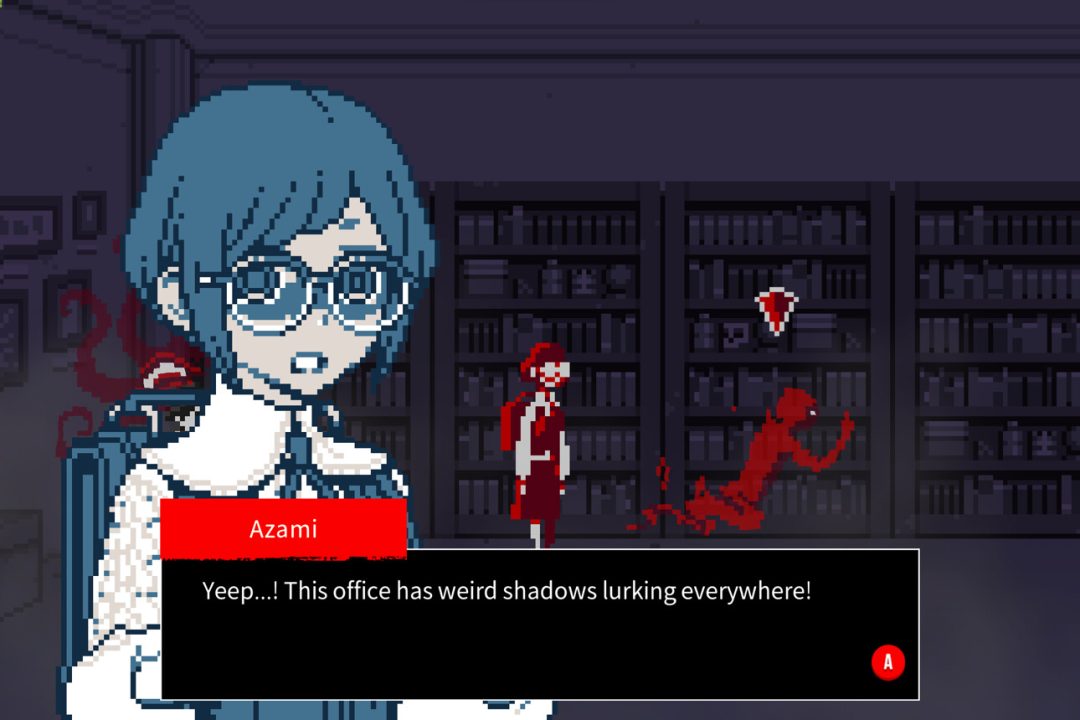Have you heard the one about the couple in the car and the escaped murderer with a hook for a hand? You haven’t? It’s terrifying; a friend of a friend told me about it. Don’t worry, though. You won’t encounter this tale in Urban Myth Dissolution Center, but you will find a host of other examples from popular legends that are definitely, positively true, or so the woman down the pub told me.
If, like me, you enjoy the type of chilling tales that you might find chronicled in the Fortean Times, this is the visual novel for you. Urban Myth Dissolution Center focuses on a young woman named Azami, who possesses the gift of clairvoyance. Concerned about the effects of this power, she finds herself in the titular institution, seeking help. She meets the wheelchair-using Director, Meguriya, who asks her to demonstrate her abilities using a special pair of glasses that he gifts to her. Through an unfortunate sequence of events, she ends up working for the Center as one of the most unlikely detectives in gaming since a certain behatted, yellow, electric squirrel hit the screens. Azami suffers from a lack of confidence and a nervous nature, so she’s perhaps not the ideal person to deal with potentially dangerous supernatural phenomena.
The Urban Myth Dissolution Center responds to contact from troubled citizens who request assistance with unusual problems. Although these unlucky individuals seek help, the aid they get from Azami under the direction of the eccentric Meguriya is often far from what they expected or desired. Meguriya seems more interested in unravelling the mysteries behind the urban myths rather than dealing with their consequences.
This creates the gameplay’s structure. The game is divided into episodes, and we join Azami at the start of each one as Jasmine, the only other employee of the Center, drives her to the scene of the incident. Jasmine complements Azami by being her opposite in demeanour, packing a laid-back attitude, strengthened by a lack of willingness to take any nonsense. Jasmine constantly insists that she is “only the driver” but soon dispels this illusion through her actions.
While travelling, Jasmine encourages Azami to research the case in question using social media. This takes you to a screen where you scroll through comments from the wider public. As you select each one, Azami and Jasmine add their commentary. Occasionally, words stick out and Azami can use the glasses to identify them, adding them to your list of search terms. You use these individually or in pairs, taking you deeper into the context of the myths, until you finally complete the social media investigation. This provides you with a powerful illusion of choice. Urban Myth Dissolution Center makes you feel as if you are scouring the dark underbelly of the interwebs, with anonymous posters weighing in on different sides of each issue. Some appear misinformed, and just as in real life, unpleasant trolls abound, with our two leads expressing their disgust at their contributions. I felt compelled to read every comment and gather each morsel of information, so strong was the urge to bury myself deeper into this world.
Soon, you arrive at your destination, which usually contains one or two interconnected screens with interactive items and people. Azami questions each subject individually, sometimes returning to Jasmine, who reluctantly offers her advice.
Haunting pixel graphics grab you from the earliest moments of the experience, laid out in soft blue tones accompanied by shades of piercing red, forming a disconcerting contrast. The aesthetic is one of horror adventure games from the late 1980s, and the lack of detail only adds to the sense of being at the wrong angle to events. I get the same feeling from watching Twin Peaks, as if these normal-seeming urban surroundings are only one step away from peeling back to reveal something shifting and formless under the surface.
The character portraits are also pixelated but contain substantially more complexity. These depictions masterfully capture the personalities of each character in the game, especially the Center staff themselves. Azami is constantly on the verge of tears, yet exudes energy and nervous charisma. I particularly love her startled expression when she answers an unexpected call from the Director, with the light of the phone’s screen reflected in her eyes. By comparison, Jasmine is super-cool, looking at you with side-eye, her head cocked, a smirk painting her face. Perhaps most engaging is the Director, with his wide eyes framing a contemplative expression that is frequently in danger of slipping into mania. That is not to imply a lack of effort afforded to the rest of Urban Myth Dissolution Center’s cast, though. From the dishevelled countenance of Azami’s beleaguered friend Mio to the slick-backed beauty of irritating influencer Jun Mayusaki, the visuals manage to fully immerse you in this world of shadows behind substance in a few illustrated expressions and mannerisms.
You’re already hip-deep into the mythology when you begin investigating the cases. Developer Hakababunko clearly understand that, if a visual novel wants to avoid the possibility of boredom setting in, they need additional mechanics to keep the player’s attention. In Urban Myth Dissolution Center, Azami gathers clues as described above, however, our paranormal protagonist has more in her arsenal than a trusty journal. She uses her special spectacles to access her clairvoyance, which makes cryptic echoes of the past visible to her, standing out in scarlet likely guilty bloodstains dripping down the screen. They often take the form of distorted figures, which remind me of art in The Case of the Golden Idol. It’s as if Azami’s brain is translating them into something comprehensible. Examining these eerie constructs gives Azami more leads, which she uses to further question those involved.
Azami must put these clues together, and this is where the comparisons with Idol grow stronger. Urban Myth Dissolution Center presents you with a phrase containing missing words, and you must choose from a list to successfully complete the puzzle. This is nowhere near as complex a procedure as Idol‘s version, and if you keep trying combinations, you find the right answer quickly. However, it does nicely break up the flow of play. Also, you feel like a super-charged Miss Marple when you choose correctly the first time around.
Eventually, the Director calls Azami and they enter a phase of the investigation called “Identification.” This calls for you to select from a list of options with no chance of total failure, as you can pick again immediately afterward. These interactions occur in a dreamlike space with two pillars surrounding stairs leading upwards, resembling Gozer’s domain in Ghostbusters. The urban myths you deal with originate from both Western and Japanese culture. Some are likely familiar, and Urban Myth Dissolution Center provides intriguing journal entries for those you might not recognise, which make good jumping-off points for further research.
These phases are bookended with the culmination of each chapter, “Dissolution,” where the Director and Azami pull a case apart according to what they’ve learned, determining truth behind the myth. I don’t feel it’s too spoilery to share that frequently the cause of events is not supernatural. I had no issues with this, even as someone who hates it when the spooky ghost turns out to be completely explicable (That banging in the walls you heard? Why, it was just my pet pig Squoinky, looking for truffles.)
Urban Myth Dissolution Center resolves these cases well, with unexpected yet logical turns of events that never fail to surprise and delight me. As with Identification, this process takes place in an otherworld of the mind, with enjoyable animations to illustrate your progress as you solve the problem before you. The superb translation and localisation effort form the foundation of this success. Sure, there are a few errors and occasionally a sentence that doesn’t seem to follow from what preceded it, but these instances are greatly outweighed by the humour and horror the writers convey with their work.
The soundtrack supports the blend of humor and horror, aiding the mood with appropriate pieces for each section. The investigations feature shadowy electronic music which becomes even eerier when Azami dons her glasses. Each chapter concludes with an excellent vocal song, which includes hip-hop elements, and wonderfully counterpoints the incidental score. At points, I did wish for a little more variety, but as Urban Myth Dissolution Center reaches its climatic end, the number of tracks increases.
Reaching that finale is well worth your time, as it brings together elements from each of the previous episodes into a spectacular finish, with multiple twists. I’m still thinking about the final post-credits scene even now. Just wait, and in a minute, I’ll tell you more about why you should play this game immediately. It’s just that there’s a scratching sound coming from the front door, and I need to go and find out what’s making it…






